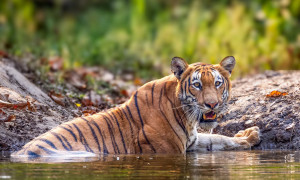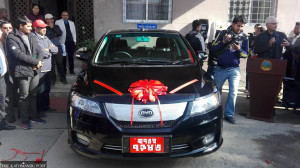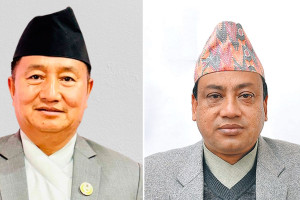Entertainment
Restoring the Panchmukhi Hanuman Temple
As the Nepali government struggles to define a game plan for how to proceed, the recently restored Panchmukhi Hanuman serves as a best practice model that future projects can learn from
Sophia L Pandé
The earthquake a year ago destroyed and damaged innumerable buildings, homes, schools, government buildings, roads, and also many, many monuments and buildings that are invaluable to both our history, but also continued to inform our living culture today, particularly in the Durbar Squares of the Kathmandu Valley which are unique as World Heritage Sites in that they are a part of the communities that live in and around them, worshipping within the temples, gathering water from the century old water systems, and continuing the traditions that essentially involve the physical presence of these sites.
After the earthquake, the government conducted a Post Disaster Needs Assessment (PDNA) to estimate the entirety of the damage within Nepal. That PDNA earmarked $205 million for the rehabilitation of the entire “Culture” sector—a sum that is fairly arbitrary when one realises that each damaged monument or site must go through a rigorous process of appraisal before it can be allocated a separate budget for, among other things, the tricky process of the calculation of the significance of both tangible and intangible heritage (meaning both the importance of the building itself but also its cultural value), careful dismantlement, the identification and training of artisans, material procurement, and an overall approach that is conducive to the intricate, complex process of taking apart and rebuilding or restoring centuries old monuments that have, in turn, gone through their fair share of earthquakes and renovations over the Malla, Shah, and Rana eras.
It is also important to understand that the burden of seeing that all these monuments are correctly restored falls squarely on the shoulders of the Department of Archaeology, a huge responsibility that even a high-functioning, efficient, easily mobilised branch of government would find daunting under such circumstances. Even were the government able to allocate the necessary amount towards restoration and conservation (which at this point, with over $400 billion pledged to Nepal is not an impossible expectation) – there would be serious lack of manpower, expertise, and a continued confusion in the designation of responsibilities about how to move forward over the coming decade. In the end, the government of Nepal, the Department of Archaeology, and all concerned stakeholders (including the public) must scrutinise and come up with the most efficient possible way to start mobilising resources for restoration, both human and financial, not just for the sake of tourism, but for the sake of how we will position our own identities which are inextricably linked to these thousands of damaged sites.
The Kathmandu Durbar Square was horrifically impacted by the earthquake. The tragedy of the complete collapse of the Kastamandap was almost compounded by an ill-considered move by the Department of Archaeology to rebuild it without any requisite research and due process; an attempt that could have proven catastrophic had it not been stopped in time. These are the inherent dangers in rushed reconstruction efforts that could do irreparable damage.
The Hanuman Dhoka Museum complex within Kathmandu Durbar Square, which is laid out in the adjoining aerial drawing, was badly damaged. Any sightseer, even today, more than a year later, will get prickles up their spine walking through all of the various chowks, some of which have buildings that are on the verge of collapse. The museum complex, guarded by the Nepal Army, is the natural storage space of most of the components of the collapsed monuments that were retrieved after the earthquake with the help of the army. Wooden struts and pieces of temples from all over the Durbar Square are painstakingly grouped together according to where they came from and are visible for any interested, wandering visitor.
Astonishingly, in the main Nasal chowk, on the south east corner of the Malla era building which encloses the Sundari and Mohankali chowks, the stunning, circular, five-tiered Panchmukhi Hanuman temple, built by the Mallas in circa 1655 AD has just seen a successful restoration that was helmed by the Hanumandhoka Durbar Museum Development Committee, which works under the Department of Archaeology. With a third of the total funds provided by the US Ambassador’s Fund for Cultural Preservation, the remaining two-thirds was provided by the Department of Archaeology for a total budget of $226,494.44.
Spurred by an understanding by the Hanuman Dhoka committee that this unique five-tiered temple had become fundamentally unstable over the years, the restoration project was underway before the earthquake, with funds in place, although the physical reconstruction work had not yet begun in April 2015 when the earthquake struck. Due to the hard-work and the fortuitous circumstances of having cash in hand, the work on fortifying and restoring the Panchmukhi Hanuman temple began in earnest in September, 2015 after following all legal procedures such as allocating the contract to the lowest bidder (according to government rules), as well as a rigorous research process that defined the parameters within which the three Steering, Consultative, and Working Committees moved in concert to execute the multi-pronged (research, re-construction, monitoring, documentation) approach required for a successful restoration.
The entire process has been fully pictorially documented by Impact Productions, a private entity that does cultural heritage documentation that worked hand in hand with the Project Implementation Committee which consists of Rajni Shrestha and Alok Tuladhar from Impact Productions who worked as Project Coordinator and Assistant Project Coordinator respectively; Bishnu Raj Karki as Project Director (and former Director General of the Department of Archaeology), and Saraswati Singh as Associate Project Director. The committee also includes architectural conservationist Dr Sudarshan Raj Tiwari, structural engineer Dr Premnath Maskey, engineer Gopal Jha, archeologist and art historian Dr Mukunda Aryal, and a senior chemist Griha Man Shrestha. The list goes to show the multitude of disciplines that must work side by side for such an endeavor.
There are detailed accounts of every single step that took place during the restoration process, but in a nutshell, the Panchmukhi Hanuman was restored by carefully taking apart the top three tiers so that they could be rebuilt with proper fortification. The base and the subsequent floors were also reinforced with wooden posts that bear the weight of the entire structure. As layers were stripped away or removed all together, every aspect was carefully noted and pictorially documented as seen in the accompanying photographs.
In addition to the fortification of the building, the Panchmukhi Hanuman temple’s south façade was restored to its original form by removing an addition made in the late 18th Century where a portico was added to the south side (facing the Nasal chowk) of the temple so that the upper floors of the temple where the idol is housed could be accessed by the priest from the outside without going through the previous ground floor entrance of the building in which Rana Bahadur Shah had been imprisoned at the time.
The removal of this outer portico access point revealed the original carved window of the south face. In order to continue the natural progression of the roof from the east side onto the south, the Project Implementation Committee then had to replicate the five layered cornice (see in adjoining photographs) which was simple enough, but additionally had to brainstorm on how to design and carve the four struts that needed to be placed to support the extension of the roof; the original struts from before had been long lost.
Speaking to Dr Bishnu Karki, the project director, about the process of understanding what the iconography of the struts may have been was a fascinating instruction in the science of images or pratima bigyan, as he explained the ways in which scholars study the traditional iconography of struts across the valley, extrapolating the most logical fit in terms of what might be missing, and then proceed to find the best possible example from which our contemporary wood carvers can emulate the chosen images with just the right proportions.
In the case of the Panchmukhi Hanuman temple, Dr Karki and his colleagues had deep discussions before deciding upon the Hanubhairab, the Panchmuki Hanuman, and the Chandra, and Surya for each of the four struts that now adorn the south façade(see adjoining photos); these struts were then carved by master carvers from Bungamati.
Today the Panchmukhi Hanuman serves as a best practice model that future projects can learn from; the team will be releasing a book in a few weeks time that will be available to the public to buy for a nominal sum. The ethics and the considerations that surround conservation and restoration and the correct practices may still be a subject of conflict and varying opinions (for example, there are directly opposing factions when it comes to the use of newer materials such as metal and concrete versus sticking only to the materials originally used for construction) but regardless, the methodology used for this project, with its conscientious documentation, due process, following of procedure, consultation with the public, and absolute transparency in terms of the both finances and the decision making procedures make for a heartening example of what is possible in Nepal, even without the support of international experts.
Much more can, and ought to be written about this project, but in the meanwhile, as the Nepali government struggles to define a game plan for how to proceed, we can at least rest assured that at least one remarkable monument remains safe, for now.




 22.39°C Kathmandu
22.39°C Kathmandu












